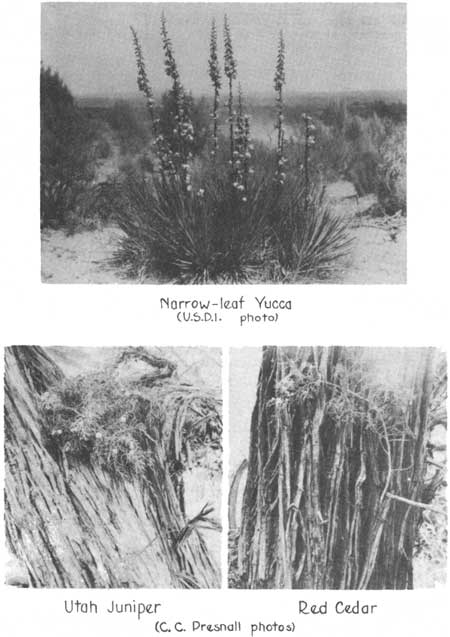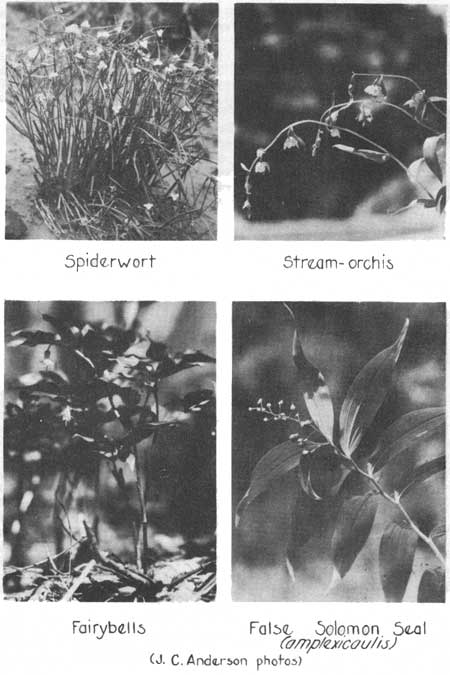|
ZION
Plants of Zion National Park |

|
Zion-Bryce Museum Bulletin
Number 1
PLANTS OF ZION NATIONAL PARK
Families of Plants
(continued)
GRASS FAMILY (POACEAE)
This is one of the largest and most important plant families, especially since it furnishes much of our food, such as corn, wheat, rice and other cereals. The flowers, however, are inconspicuous, being wind pollinated, and hence they escape the interest of most people. For those making a study of the family we have included the following list of kinds known from within the park. Specimens of most of these are in the Zion Museum.
| Andropogon saccharoides | Beardgrass |
| Sorghum halepense | Johnson Grass |
| Hilaria jamesii | Gelleta Grass |
| Panicum capillare | Witchgrass |
| Setaria lutescens | Bristlegrass |
| Cenchrus pauciflorus | Sandbur |
| Aristida glauca | Three-awn Grass |
| Aristida fendleriana | Fendler Three-awn |
| Stipa comata intermedia | Needlegrass |
| Oryzopsis hymenoides | Indian Ricegrass |
| Muhlenbergia andina | Foxtail Muhly |
| Mublenbergia curtifolia | Muhly |
| Muhlenbergia wrightii | Spike Muhly |
| Phleum pratense | Timothy |
| Polypogon monspeliensis | Rabbitfoot Grass |
| Agrostis verticillata | Bentgrass |
| Koeleria cristata | Junegrass |
| Chloris virgata | Fingergrass |
| Bouteloua curtipendula | Side-oats Grama |
| Phragmites communis | Common Reed or Canegrass |
| Distichlis stricta | Desert Saltgrass |
| Dactylis glomerata | Orchard Grass |
| Poa fendleriana | Mutton Grass or Bluegrass |
| Glyceria striata | Fowl Mannagrass |
| Puccinellia nuttalliana | Alkali-grass |
| Festuca octoflora hirtella | Six-weeks Fesque |
| Festuca pacifica | Fesque |
| Bromus tectorum | Cheat Grass or Downy Brome |
| Bromus rigidus | Ripgut Grass |
| Bromus marginatus | Large Brome |
| Bromus polyanthus | Many-flowered Brome |
| Agropyron inerme | Beardless Wheatgrass |
| Agropyron pauciflorum | Slender Wheatgrass |
| Hordeum murinum | Mouse Barley or Foxtail |
| Hordeum nodosum | Meadow Barley |
| Hordeun jubatum | Foxtail |
| Elymus canadensis | Rye Grass |
| Sitanion hystrix | Squirreltail |
SEDGE FAMILY (CYPERACEAN)
The plants in this large family are regarded by the general public simply as grasses, from which they can be distinguished by their three-cornered stems. The large BULRUSHES, Scirpus sp., are however, easily recognized by everyone as marsh plants distinct from the grasses. The well-known Tule belongs to this group. The following members of the family have been found in Zion:
| Scirpus validus | Scirpus microcarpus | Carex aurea |
| Scirpus acutus | Eleocharis palustris | Carex festivella |
| Scirpus paludosus | Carex occidentalis | Carex rostrata |
DUCKWEED FAMILY (LEMNACEAE)
COMMON DUCKWEED, Lemma minor, is found on almost all ponds and streams in the park. It is the smallest of all flowering plants, without stems or leaves, consisting simply of small leaf-like discs which float on the water, with tiny rootlets and flowers that usually escape notice.
SPIDERWORT FAMILY (COMMELINACEAE)
The SPIDERWORT, Tradescantia scopulorum, is common in sandy places in all parts of the park except the high plateaus; most noticeable along the Narrows Trail and at the east entrance. The blue flowers, which bloom at night, wilt during the daytime. (Plate III).
RUSH FAMILY (JUNCACEAE)
This is another group of grass-like plants with very small lily-like flowers, of little interest to the majority of visitors. The following kinds have been found in the park:
| Juncus balticus | Juncus regalii |
| Juncus mexicanus | Juncus torreyi |
| Juncus bufonius | Juncus xiphioides |
| Juncus tenuis | Juncus brunnescens |

PLATE II
LILY FAMILY (LILIACEAE)
The plants in this family have simple parallel-veined leaves and flower parts in 3's or 6's.
MOUNTAIN DEATHCAMAS, Zygadenus elegans. An onion-like plant with long loose heed of small yellowish-green flowers. Not common; found sparingly in meadows or wet places om the plateaus. This species is not so deadly poisonous as some.
WILD ONION, Allium acuminatum. A small onion, 6 inches to 1 foot high, with a round loose cluster of pale purple flowers, blooming from April to June. Occurs throughout the park above 4000 feet, but is nowhere common.
BRODIAEA or BLUE DICKS, Hookera capitata. Found sparingly throughout the park in good soil; most common in Upper Sonoran Zone, noteably at the beginning of the Narrows Trail. Blooms in April and May. A sub-species, pauciflora, has been found in Coalpits Wash.
FRITILLARY, Fritillaria atropurpurea, A small lily, about 1 foot high, with slender leaves and 1 to 4 small brownish-purple flowers with yellow spots; a miniature leopard lily". Rare; in sagebrush flats, blooming in May and June.
SEGO LILY or MARIPOSA LILY, Calochortus nuttallii. The State flower of Utah. Showy, cream-colored, tulip-like blossoms on erect stems about 1 foot high. Each petal has a purple eye-spot near its base. Common on flats and slopes between 3500 and 4500 feet; less common up to Transition Zone. All the mariposa lilies here bloom in May or early June. Another species, flexuosus, resembles it closely, but has a twining stem, often branched. The YELLOW SEGO LILY, Calochortus aureus, is a low-growing lemon-yellow species known in Zion only from the Petrified Forest.
NARROW LEAP YUCCA, Yucca angustissima. (Plate II) The sharp dagger-like leaves of the yucca cause many to think it related to the cactus, but its waxy white flowers, blooming in May and June, show that it is a lily that has adapted itself to desert conditions. Common in dry places in both Sonoran Zones, but most common in the Lower. Another species, Yucca baccata, with thick, gray-green leaves, and short flower stalk, is also found in the same general range but most commonly in the Upper Sonoran Zone.
Two kinds of FALSE SOLOMON SEAL grow in all the cool, moist canyons: Vagnera liliacea, having narrow leaves and dark purple berries; and Vagnera amplexicaulis, with wide leaves and light red berries. (Plate III). The narrow-leaf form is much the most common. Both kinds usually bloom in June — tiny white flowers. They differ from the true solomon seal in having a cluster of terminal flowers rather than one in each leaf axil.
FAIRYBELLS, Desporum trachycarpum. (Plate III) A rather uncommon plant in cool canyons, usually above 5500 feet altitude. A branching, heavy-stemmed plant, 1 to 2 feet high, with broad oval leaves, inconspicuous white or greenish flowers, and red three-lobed berries.

PLATE III
ORCHID FAMILY (ORCHIDACEAE)
Highly developed plants with irregular, 3-petaled flowers, 1 petal usually forming a spur or lip. All species in Zion have green parallel-veined leaves, and none are common.
REIN-ORCHIS, Habenaria dilatata. A tall spike (1 to 2 feet) of small white or greenish flowers; several leaves about 6 inches long near the base, Wet places on the plateaus, in thick woods; blooms in June. RATTLESNAKE-PLANTAIN, Peramium decipiens is somewhat similar but smaller, with smaller basal leaves sometime splotched with white. More often found than the preceding, in moist canyons and wet Transition Zone forests. Blooms in August.
STREAM-ORCHIS, Serapias gigantea (Plate III) Our most showy orchid, with greenish-white purple-veined flowers appearing in May or June. Wet places under ledges and in wooded canyons between 4000 and 7500 feet altitude. Best seen on Emerald Pool and Great Arch Trails.